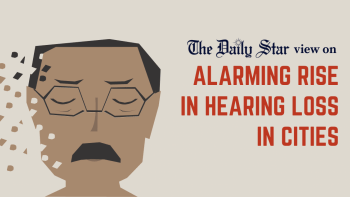Dissection of an urban soundscape

Urban landscape defines its soundscape, which varies from one neighbourhood to another. Urbanites must deal with two types of sound: one produced inside the house and another from outside the home. In urban areas, cacophony triumphs over symphony. Cacophony ranges from automobile honking to thunderous din of construction work. Even at midnight, the honking does not stop. Revving engines makes the situation worse. We are always on the move. Night is not the time to rest rather, it seems to be a time of busy schedules. Products are delivered from door to door. The virtual marketplace provides the symbols of real-life objects. By placing orders, we bring cacophony within our earshot.
Automobiles, by compressing time with their fuel-driven engines have become an indispensable part of our lives. Time is always in short supply. Our fast and furious biographies always need a touch of perfection. We cannot afford to use our feet or ride a cattle cart to reach our destination. We cover long distances by using machines to minimise the time. Time has become synonymous with zero-sum game money.
Modern shelters are constructed to accommodate the growing population producing unbearable noise by piling machines. It does not stop even at night. People can hardly sleep in this environment. Construction work is a nightmarish experience for the residents who have very little power to change the scenario. The flat owners are in a Catch-22 situation, whereas the tenants have the option of moving out. The gigantic and unimpressive machines of construction work create a feeling of helplessness by producing massive noise.
Dogs bark to claim their porous territory against other dogs. Cats fight against other cats for the same reason. Their respective calls make their presence felt in an environment riddled with machine noise. The prolonged barking of dogs sometimes numbs our hearing power. At night, sounds of dogs barking become audible, remaining shrouded under automobile honking during daytime. Slogans make their presence felt when the political situation is volatile. During the blackout, the diesel generators spew out black smoke producing deafening noise. Movie theatres hammer on the senses by creating a pool of surround sound.
Peddlers shout the name of their commodities to attract potential buyers. They sell a range of items from hot patties to peanuts to vegetables. They also peddle fish and hurl the names at the residents to find their prospective vendees. Beggars beg for alms by their repetitive appeal. Their voices remain an integral part of the urban soundscape.
Airplanes help us reach our destination within the shortest possible time. The growling sound of their engines does not allow us to hear our mutual conversation. Sound pollution from airplanes is a unique phenomenon of modern civilisation. Calling bells in their varieties of sounds breaks our usual engagements to address the issue outside the door. Being startled by the sound we rush towards the door. Calling bells break our temporary meditation and bring anxiety. Sometimes to the chagrin of the residents, mischievous children ring the bell and run away. Television is another source of voluminous sound inside the room produced voluntarily by the inhabitants. Serials and their accompanying sounds produce suspense along with their repeated close-ups travel across the neighbourhood. Movie theatres are replicated at home with the help of hi-fi sound.
The wailing sound of ambulances signals the transportation of sick passengers. The siren of the fire service truck makes everyone alert about an incident of the nearby fire. Both ambulances and fire service trucks point to the crisis in a situation. Drilling machines produce disturbing noise that we cannot escape from. Aluminium glass and brick walls erected to stave off unwelcome sounds from roads and highways struggle to live up to the expectation.
The Muslim call to prayer five times daily remains the constant companion of the residents. The muazzin in his soothing and enchanting voice calls the practicing Muslims to the mosques. Azaan finds its way into our lives due to the Muslim majority of the population. When I had to live for certain days in Mukundapur in India, I did not hear azaan at all as it was a Hindu-dominated area. There, Hindu religious songs were played on microphones all day long during different festivals. Religion determines the types of sound in a geographical location.
Musical concerts organised by the bride's and groom's family as part of the wedding ceremony in the winter make the situation a terrible one. Ceiling fans fail to hide the noise as they remain out of use due to the colder temperature. In winter the honking of automobiles gets on our nerves, and it feels like the vehicles are moving not on the road but inside the rooms.
The symphony of nature is also felt in the urban soundscape. Birds chirping cheer us up giving the torch of rejuvenation. The rhythm of torrential rain is heard quite often in the monsoon. The sound of jackals or crickets is missing from the urban soundscape. Thunder rumbles during the monsoon helping us to forget the machine-generated noise for a while. The opportunity cost is too heavy for us to deal with in urban areas. The future of urban soundscape is not going to improve in terms of machine-derived sound before we become partially or fully deaf.
Mohammad Mahfuzul Islam is an anthropologist working at Independent University, Bangladesh.
Views expressed in this article are the author's own.
Follow The Daily Star Opinion on Facebook for the latest opinions, commentaries and analyses by experts and professionals. To contribute your article or letter to The Daily Star Opinion, see our guidelines for submission.

 For all latest news, follow The Daily Star's Google News channel.
For all latest news, follow The Daily Star's Google News channel. 





Comments